After a September Rain – A Good Time to Weed a Sunny Edge
We had some good rain in the last few days, almost an inch over a two-day stretch. That’s not nearly enough to saturate the ground, but enough to soften the top layers and make it easier to remove shallow-rooted invasives. I decided to check out a few spots on the edge of canopied forest that had once been covered in old-growth Ivy and are now in the process of regeneration of native plants.
In the first sunny edge I visited, I was dismayed to see a significant new infestation of Herb Robert covering a couple hundred square feet. I wondered how it could have gotten so far along since the last time I weeded in May. I began by circling the infestation and finding out how far it had spread. Then I began removing the Herb Robert, working around the outer edge towards the middle. I wanted to at least contain it, if for some reason I didn’t finish and couldn’t get back for a while. In this case I was able to get it all out in about an hour.
I had about an hour left so I went to another area that was planted with natives about five years ago and was happy to see it looked pretty good — just a few scattered Herb Roberts and dandelion-like plants to remove.
This site consists of about 800 square feet on the eastern edge of a conifer forest with poor soil and too far from a water tap to irrigate. After removing dense, old-growth Ivy, it was planted with Sword Fern, Salal, Oregon Grape, Inside-Out Flower, and Beach Strawberry and sheet mulched. Since then I have kept it free of invasives and re-mulched it twice, but only about 1/4 of the plants have survived and are only now starting to spread. The Inside-Out Flower and Beach Strawberry have done fairly well, and some of the Sword Ferns, Oregon Grape, and Salal have survived, but they have not thrived. Some natural regeneration of natives has occurred. I think that with continued repeat weedings this site will eventually fill in with natives, but it has been a slow process.
I have not removed a few volunteer Douglas Firs in hopes that they will get enough sun to do well. They are growing at the foot of a large Douglas Fir, and I hope that it might “mother” them through the mycorrhizae that scientists are learning about.
